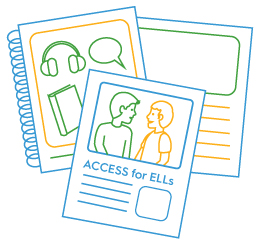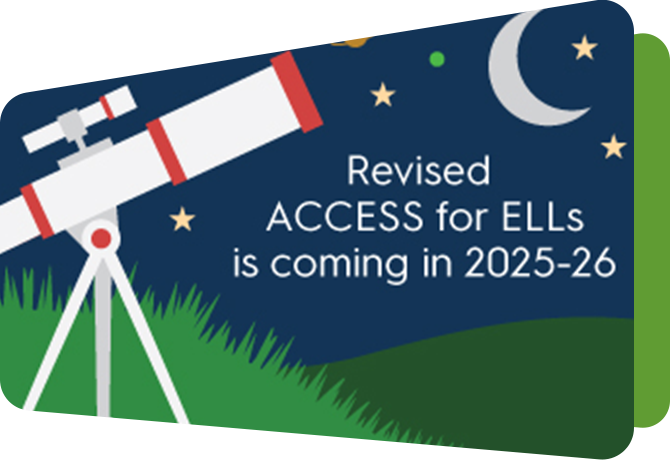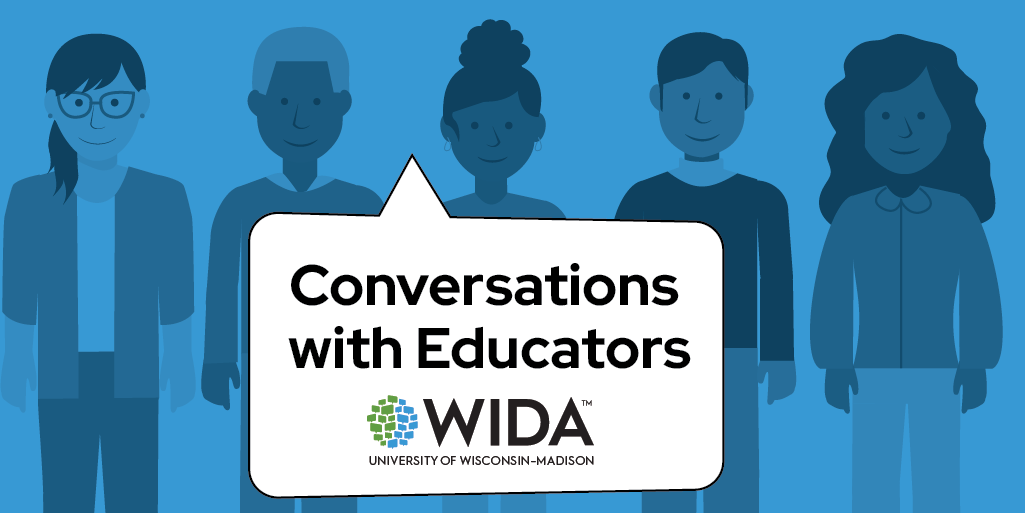Resources/Recursos
Featured Resources



All resources/Todos los recursos
Filter resources by:
Resources/Recursos
Introduction to the Updated Key Language Uses
One of the components of the WIDA ELD Standards Framework is the Key Language Uses (KLUs). The KLUs summarize the most prominent language uses across disciplines, helping educators organize and prioritize curriculum and instruction. Learn about the updated KLUs – Inform, Narrate, Explain and Argue.
Resource DetailsReleased February 2021
Promoting Equity for Young Multilingual Children and Their Families
This Focus Bulletin invites early care and education (ECE) educators to promote equity for young multilingual children and their families. In the bulletin, we offer ideas for taking a language-focused approach to equitable caregiving and instructional practice in ECE settings. Also, we highlight voices from the field, and offer reflection questions to help you consider what it means to promote equity for multilingual children and their families.
Published February 2021
Authors: Amanda Spalter, Lorena Mancilla
Released February 2021
WIDA Screener for Kindergarten Proficiency Level Descriptors
This guide illustrates a continuum of language development for multilingual Kindergarten learners and describes what they can do across six levels of English language proficiency.
Resource Details View Download NowReleased February 2021
Introduction to the 2020 Edition
Members of the WIDA standards development team share a high-level overview of what’s new and exciting in the WIDA English Language Development Standards Framework, 2020 Edition. Intended for SEA representatives, district leaders, and EL and content teachers.
Resource DetailsReleased January 2021
ACCESS for ELLs Parent Letters (multiple languages)
This letter, available in many languages, contains general information about ACCESS for ELLs and is meant to accompany ACCESS for ELLs score reports as an explanation for parents and guardians. It is provided in an editable format to allow districts and schools to include additional information regarding test administration dates and state policy.
Resource Details
Released December 2020
Performance of Technology-Enhanced Items in Grades 1–12 English Language Proficiency Assessments
Technology-enhanced items (TEIs) are innovative, computer-delivered test items that are more authentic and interactive than traditional multiple-choice items (MCIs). This study examines the performance of grades 1–12 English learners on TEIs compared to MCIs on the reading domain of ACCESS for ELLs Online.
Published December 2020
Authors: Ahyoung Alicia Kim, Rurik L. Tywoniw, Mark Chapman
Released December 2020
Introduction to the WIDA ELD Standards Framework, 2020 Edition
This video provides an introductory overview of the WIDA English Language Development Standards, 2020 Edition. It briefly highlights how the 2020 Edition fosters the assets, contributions, and potential of multilingual learners.
Resource DetailsReleased December 2020
Making Science Multilingual: An Interdisciplinary Program and its Evolution
This report discusses an interdisciplinary and interorganizational endeavor to support the science education of multilingual youth: the Making Science Multilingual program. More specifically, the report addresses the rationale for the program, milestones it accomplished, resources it required, and challenges it faced.
Published November 2020
Authors: Daniella Molle, Weiqiong Scarlett Huang
Resource Details View Download Now
Released November 2020
Illustrated Guiding Principles of Language Development (multiple languages)
This illustrated booklet, available in multiple languages, brings each of the 10 WIDA Guiding Principles of Language Development to life and can be used by educators with parents, families and community members.
Resource DetailsReleased November 2020
Translanguaging
This focus bulletin explores translanguaging from the perspective of four educators, spanning kindergarten through high school. Translanguaging, a common practice among multilingual people, can be explained as using all languages and language varieties available to communicate and understand the world around oneself. The bulletin provides specific ideas on how to use translanguaging to create spaces for students' multilingualism and includes reflection questions to help educators adopt translanguaging strategies in their practice.
Resource Details View Download Now
Released September 2020
Generating Imputed Overall Composite Scale Scores for English Learners With Disabilities Who Are Missing Domain Scores in the ACCESS for ELLs Assessment
This technical report aids WIDA Consortium members and stakeholders in producing imputed overall composite scale scores and proficiency levels for students who are missing scores in one or two domains due to a disability.
Published September 2020
Author: Narek Sahakyan
Released September 2020
El translenguaje: Enseñando en la intersección del lenguaje y la justicia social
Este boletín de enfoque explora el translenguaje desde la perspectiva de cuatro educadores, y abarca el contexto de kínder hasta el 12º grado. El translenguaje, lo cual es una práctica común entre las personas multilingües, se define como el uso de todos los lenguajes y sus variedades disponibles para comunicarnos y comprender el mundo que nos rodea. El boletín proporciona ideas específicas sobre cómo usar el translenguaje para crear espacios para el multilingüismo de los estudiantes e incluye preguntas de reflexión para apoyar a los educadores en su aplicación de estrategias de translenguaje en su práctica.
Detalles del recurso Ver Descargar ahoraReleased September 2020
Folleto de la prueba ACCESS for ELLs para padres
Este documento ayuda a los padres y a las familias a comprender la prueba de WIDA ACCESS for ELLs y sus componentes.
Detalles del recurso Ver Descargar ahoraReleased August 2020
¿Qué es ACCESS for ELLs?
Envíe este folleto de introducción a ACCESS for ELLs en español con los estudiantes cuando la prueba esté programada o como un recordatorio para los padres antes de que se le compartan las puntuaciones. Este folleto explica qué es ACCESS y por qué los estudiantes son evaluados de esta manera. Utilice este recurso para ayudar a los padres a comprender las pruebas anuales de competencia lingüística.
Detalles del recurso Ver Descargar ahoraReleased August 2020
Educación en el mundo actual
This Focus Bulletin offers strategies for advancing full and meaningful access in bilingual settings during the mundo actual of COVID-19. The bulletin emphasizes the importance of valuing multilingual learners’ linguistic and cultural wealth, using translanguaging, and leveraging technological resources.
Published August 2020
Authors: Sam Aguirre, Erika Rosales
Released August 2020
Educación en el mundo actual
Este boletín de enfoque ofrece estrategias para avanzar la equidad en los programas bilingües en el mundo actual de COVID-19. Se da énfasis a la importancia de la diversidad lingüística y cultural, el translenguaje y recursos tecnológicos para la equidad.
Detalles del recurso Ver Descargar ahoraReleased August 2020
What Is WIDA ACCESS? (multiple languages)
Send this handout, available in multiple languages, home with students as an introduction to ACCESS when testing is scheduled or as a reminder before scores are shared. This flyer explains what ACCESS is and why students take this kind of assessment. Use this resource to help parents understand annual language proficiency testing.
Note: For family handouts that explain English learner status and language testing, refer to the What Is WIDA Screener? and What Is WIDA Alternate Screener? handouts.
Resource DetailsReleased July 2020
ACCESS for ELLs: Understanding Your Child's Scores (multiple languages)
Send this flyer home with students along with the ACCESS for ELLs Individual Student Report. This flyer explains each piece of score information included in the report. Use this guide, available in several languages, to help parents understand what scores mean and how they are used.
Resource DetailsReleased July 2020
Can Do Descriptors Student Name Charts, Kindergarten
This chart allows educators to track students by their level of English language proficiency.
Resource Details View Download NowReleased June 2020
Young Multilingual Children in Maryland
In this study, completed for the Maryland State Department of Education, we explore the perceptions, experiences and decision-making of 27 parents of young multilingual children, ages birth to 5 years. The focus revolves around children’s language learning and development, family engagement practices and children’s participation in early care and education (ECE) programs.
Published 2020
Resource Details View Download NowReleased May 2020




